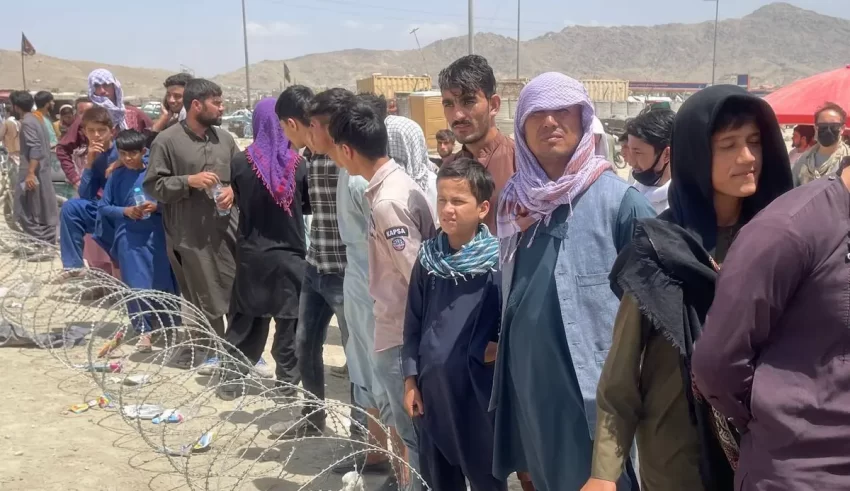
The world is still reeling from the sudden fall of Kabul on 15 August and the Taliban’s victory in Afghan territory. These events came as a surprise to the international community, as US intelligence services had estimated on 11 August that an event of such magnitude would occur within 90 days (Nieto, 2021). A few days later, scenes of desperation at Hamid Karzai International Airport made headlines around the world, signaling the beginning of a new migration crisis and the imminent risk to the country’s citizens (President Joe Biden, 2021).
Furthermore, despite the media impact of this episode, the increase in migration has been latent due to several phenomena such as the beginning of the withdrawal of NATO coalition troops, the intensification of the conflict in recent years, the crisis caused by COVID-19, environmental degradation and even the advance of Daesh in Afghanistan. Given these causes, the new migration has developed the same dynamics as previous exoduses and the refugee crisis of 2015. That is, a large proportion of Afghans will head towards the border areas with Iran and Pakistan, the largest recipients of Afghans since 1978. However, it is notable how several groups of migrants have begun to arrive at Iran’s border with Turkey, with the aim of crossing into Turkey and settling in the EU (Nieto, 2021).
As it has been stated, the irregular migrant population is therefore at a crossroads. Not having the same advantages as those Afghan citizens who managed to be safely evacuated during the Kabul evacuation, they will have to choose between two options. The first is to remain on Afghan territory, which after the collapse of its government and possible isolation from much of the world, will face an economic crisis, which is likely to aggravate the situation for citizens and stimulate illegal economies such as drug trafficking. The second is to leave the country and embark on high-risk land routes and the inflexibility of governments and their authorities (Nieto, 2021). In addition, anti-immigration and Islamophobic rhetoric is likely to increase among the population in receiving and transit states, which will have political effects in these countries (United Nations, 2022).
In this respect, for those Afghans seeking refuge or a new life in Europe, Turkey has been a major relocation centre. Following a 2016 agreement with the European Union, Turkey now permanently hosts millions of refugees and migrants, including possibly hundreds of thousands of Afghans. As a result, most of the routes through the country are closed. Due to continued large-scale deportations and Turkey’s economic crisis, they struggle to survive in an increasingly hostile environment. Despite this, there was an additional influx of Afghans in 2018 and 2019, probably further fueled by the current situation in Afghanistan (Roehrs & Hossaini, 2020).
Furthermore, there is a strong likelihood that part of the new migratory flow from Afghanistan will also be directed towards this route to reach North American territory, which will aggravate the crisis that Latin America is experiencing in this area. Addressing this situation represents an additional effort for the region’s governments, which are currently facing economic difficulties, high levels of social unrest and irregular migration flows. To address this situation, transit countries will require economic and logistical support from receiving states, which will be essential to protect the integrity of these people (Nieto, 2021). Asylum initiatives are likely to emerge in countries such as Colombia, which will have a great social impact, due to the context of the migration crisis and the lack of a historical tradition as a migrant-receiving country (UN Refugee Agency, 2023).
As we are seeing the recent events in Afghanistan have unleashed an increase in migration flows in different parts of the world, where Afghanistan citizens already face an adverse scenario of economic crisis and secrecy in the face of massive irregular migration. This increase will create a window of opportunity for migrants from other crisis regions to undertake dangerous journeys to reach better living conditions in more developed countries. In order not to experience overspill migration, these states will have to support transit countries to reduce the flow into their territory and provide mechanisms for the regularisation of this population. For their part, transit countries will face the challenges of dealing with this population directly, as well as xenophobia and problems at the local level in the host territories (Nieto, 2021). This new wave of migrants is an event that will require solidarity among states to meet the needs of this population at risk and will have to transcend unilateral actions to link countries in coordinated strategies to address the crisis (European Council and Council of the European Union, 2021).
References
- Batalova, J. (2021). Afghan Immigrants in the United States. Migration information source. Migration Policy Institute. Retrieved from: https://www.migrationpolicy.org/article/afghan-immigrants-united-states
- European Council and Council of the European Union (2021). Statement on the situation in Afghanistan. Retrieved from: https://www.consilium.europa.eu/en/press/press-releases/2021/08/31/statement-on-the-situation-in-afghanistan/
- Kugiel, P. and Szymańska, J. (2021). Afghan Refugees in the European Union: Experiences and Perspectives. The Polish Institute of International Affairs. Retrieved from: https://pism.pl/publications/afghan-refugees-in-the-european-union-experiences-and-perspectives
- Nieto, M.D. (2021). ‘Afganistán y la nueva oleada de migrantes: un hecho con consecuencias globales’ (Afghanistan and the new wave of migrants: a development with global consequences). Centro de Estudios de Asia, África y Mundo Islámico. Aladaa internacional. Retrieved from: https://aladaainternacional.com/afganistan-y-la-nueva-oleada-de-migrantes-un-hecho-con-consecuencias-globales/
- President Joe Biden (2021). Remarks by President Biden on the Terror Attack at Hamid Karzai International Airport. U.S. Embassy and Consulates in Italy. Retrieved from: https://it.usembassy.gov/remarks-by-president-biden-on-the-terror-attack-at-hamid-karzai-international-airport/
- Roehrs, C., Hossaini, K. (2020). Afghan Exodus: Migrants in Turkey left to fend for themselves. Retrieved from: https://www.afghanistan-analysts.org/en/reports/migration/afghan-exodus-migrant-in-turkey-left-to-fend-for-themselves/
- UN Refugee Agency (2023). Press Coverage of the Refugee and Migrant Crisis in the EU: A Content Analysis of Five European Countries. Retrieved from: https://www.unhcr.org/media/press-coverage-refugee-and-migrant-crisis-eu-content-analysis-five-european-countries
- United Nations (2022). Afghanistan’s Future Depends on Taliban’s Engagement with World, But Restrictions on Women Signal Lack of International Commitments, Briefer Warns Security Council. Meetings Coverage and Press Releases. Retrieved from: https://press.un.org/en/2022/sc15038.doc.htm
By The European Institute for International Law and International Relations.















